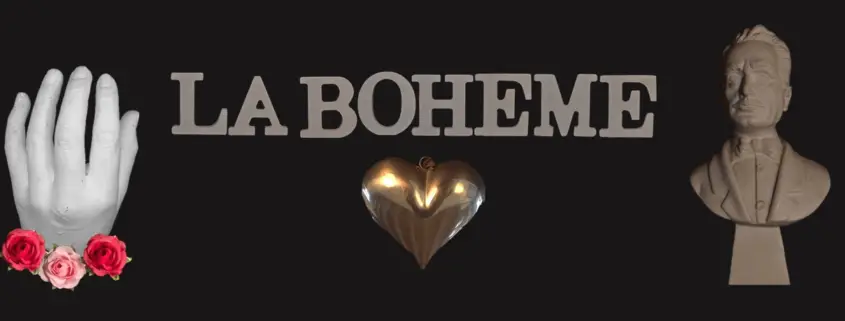CHE GELIDA MANINA – an aria from the opera La Bohème
The Portrait of Puccini’s Aria CHE GELIDA MANINA
Read Interesting facts and hear great YouTube Videos about the famous Aria “Che gelida manina”.
If you want to hear more about the opera La Boheme, click on the link to the opera portrait
The Aria – Synopsis & Background
Synopsis: The philosopher Colline comes home. He’s in a bad mood because he couldn’t sell anything in the pawn shop because it was closed on Christmas Eve. Only the musician Schaunard could earn something and brings wine, firewood and some money with him. So they decide to spend Christmas Eve at Café Momus. They are interrupted by their landlord Benoit, who duns the long overdue rent. They get rid of him and go to the café. Rodolfo is the only one left, as he still has to finish an article. There is a knock at the door. It’s Mimi, the seamstress from the neighbor’s apartment. She asks for fire for the extinguished candle. Mimi feels weak and Rodolfo takes care of her. The two talk about their lives and their dreams. Rodolfo begins and tells of himself, the poet, the millionaire of dreams.
The famous aria “che gelida manina” begins pianissimo and dolcissimo and the first part ends with a beautiful rallentando when Rodolfo points to the beautiful moon that romantically shimmers into the room (e qui la luna). Rodolfo introduces himself with an expressive “Chi son” in which he describes himself as a poet and poor artist. In the third part he tells of his dreams, which culminates gloriously in the word “millionaria”. In the fourth part he sings about Mimi, whom he has just met. The famous closing sequence with the high C (Ma il furto non m’accora, poiché, poichè v’ha preso stanza, la speranza) is infinitely romantic.
The Aria – the text of che gelida manina
Che gelida manina, se la lasci riscaldar…
Cercar che giova? Al buio non si trova.
Ma per fortuna, è una notte di luna,
e qui la luna… l’abbiamo vicina.Aspetti, signorina,
le dirò con due parole:
chi son? chi son!… e che faccio…
come vivo?… Vuole?
Chi so? Sono um poeta.
Chi cosa faccio? Scrivo.
E come vivo? Vivo.In porvetà mia lieta,
scialo da gran signore…
rime ed inni d’amore.
Per sogni e per chimere…
e per castelli in aria!
L’anima ho milionaria.
Talor dal mio forziere…ruban tutti i gioelli
due ladri: gli occhi belli.
V’entrar com voi pur ora,
ed i miei sogni usati
e i bei sogni miei tosto si dileguar!
Ma il furto non m’accora,
poichè v’ha preso stanza… la speranza!Or che mi conoscete, parlate voi deh! parlate…
Chi siete?
Vi piaccia dir?
What a frozen little hand,
let me warm it for you.
What’s the use of looking?
We won’t find it in the dark.
But luckily
it’s a moonlit night,
and the moon
is near us here.Wait, mademoiselle,
I will tell you in two words,
who I am, what I do,
and how I live. May I?
Who am I? I am a poet.
What do I do? I write.And how do I live? I live.
In my carefree poverty
I squander rhymes
and love songs like a lord.When it comes to dreams and visions
and castles in the air,
I’ve the soul of a millionaire.
From time to time two thieves
steal all the jewels
out of my safe, two pretty eyes.
They came in with you just now,
and my customary dreams
my lovely dreams,
melted at once into thin air!But the theft doesn’t anger me,
for their place has been
taken by hope!
Now that you know all about me,
you tell me who you are.
Please do!
Famous interpretations of Che gelida manina
We start with Pavarotti. Many experts consider Pavarotti to be the best Rodolfo in recording history. In the words of Kesting: “Poorly outstanding, also and especially acting, Pavarotti is presenting himself as Rodolfo under Karajan. It is one of the rare vocal portraits that makes the figure visible. In no other record- apart from La fille du régiment – has he sung more freely and relaxedly, in none with a richer palette of colours.”
Che gelida manina (1) – Pavarotti/Karajan
The next Rodolfo is the great Jussi Björling. Again with the words of Kesting: “No other sang the music of the first act more luminously and tenderly, that of the fourth act more restrainedly and elegantly than the Swede”.
Che gelida manina (2) – Björling/Beecham
The next recording is by Benjamino Gigli from the 30s. He was long regarded as the successor of Enrico Caruso. Gigli’s voice had “the liquid metal as well as the velvety softness” (Fischer) or “the warmth and brilliance” (Kesting). Gigli irritated many opera lovers with his excursions into the shallow entertainment and was occasionally condemned as a “Schmalztenor”, a verdict he shared with Richard Tauber, another great tenor of the 20th century. It is indisputable how Gigli was able to reproduce emotions with his voice (this is especially evident in the first part), while the highest notes (as with Caruso) were not the tenor’s compelling strength. But at the end you hear a beautiful diminuendo.
Che gelida manina (3) – Gigli
You can hear a fourth version by Jonas Kaufmann.
Che gelida manina (4) – Kaufmann
Peter Lutz, opera-inside, the online opera guide to CHE GELIDA MANINA from the opera La Bohème




very useful. Thank you